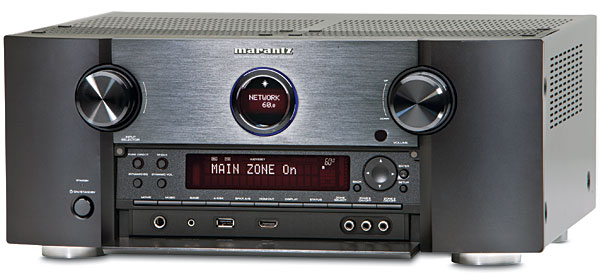Marantz SR7007 A/V Receiver Page 2
The Woman in Black is noteworthy for the supernatural shocks, with accompanying sound effects, that pursue Daniel Radcliffe through a haunted house. Thanks to the receiver’s dynamic prowess, these effects would rise out of a background of dead silence to a split second worth of sonic violence and then disappear as abruptly as they arrived. The first time it happened, I jumped, and even the second and third times I was unable to steel myself against the sudden shocks. Eventually the shocks came thicker and faster and the mix became more conventionally busy, but late in the game, I remained unsettled: The last entry in my notes is “spine tingle.” When the receiver and soundtrack weren’t terrorizing me, they offered the gentler pleasures of a moody and smoothly rendered orchestral score, sensations of enveloping rain punctuated by thunder, and still more scrupulously pitched ominous rumbling.
 Bridesmaids relies almost entirely on the human voice for its storytelling. Deborah Harry’s pouty lead vocal in Blondie’s “Rip Her to Shreds” kicks off the story, and the receiver lost no time strutting its ability to make music feel—well, musical. Comedy alpha-woman Kristen Wiig dominates the dialogue as both lead character and Oscar-nominated cowriter of the
script, forming it into a nervous laughing brook that became one of the most subtle but pleasing sonic elements of the movie demos. The system’s natural reproduction of dialogue humanized the characters. A more etched system might have nailed the words but missed the human feeling.
Bridesmaids relies almost entirely on the human voice for its storytelling. Deborah Harry’s pouty lead vocal in Blondie’s “Rip Her to Shreds” kicks off the story, and the receiver lost no time strutting its ability to make music feel—well, musical. Comedy alpha-woman Kristen Wiig dominates the dialogue as both lead character and Oscar-nominated cowriter of the
script, forming it into a nervous laughing brook that became one of the most subtle but pleasing sonic elements of the movie demos. The system’s natural reproduction of dialogue humanized the characters. A more etched system might have nailed the words but missed the human feeling.
Putting It All Together
Emerson, Lake & Palmer’s Tarkus (on vinyl) brought together several of the receiver’s most desirable attributes. I won’t say the frequency response was ruler-flat—that’s for the measurements to determine—but it felt natural and right to
me. The soundtrack’s layering
of timbre-rich keyboard instruments was as impressive
as I’ve ever heard, and I’ve played this record on every system
I’ve owned since childhood.
The Audyssey-tweaked rhythm section presentation was tight and disciplined, easily improving over the non-room-corrected systems of my youth. But it also called attention to the low-frequency component of Keith Emerson’s whooping Moog
and the percolating snap of
his Hammond. Imaging
was impressive at any volume, held together even at high volumes, and was especially delectable when Greg Lake’s silver-trumpet vocals were doubletracked.
The receiver continued to flatter the human voice—masses of them—in A Sea Symphony by Vaughan Williams, performed by the Atlanta Symphony Orchestra and Chorus under the baton of Robert Spano. The Telarc DSD recording may have lost some of its state-of-the-art resolution in this CD release, especially in the strings, and the receiver didn’t attempt to gussy it up with faux-enhancement. But that didn’t prevent the Marantz from floating the chorus between the speakers in luminous near-holography, giving the libretto from Walt Whitman’s Leaves of Grass a palpable physical presence.

James Blood Ulmer’s Are You Glad to Be in America? (the short answer is yes) practically cries out for room correction. I’ve always found the LP’s dual rhythm section of Ronald Shannon Jackson and G. Calvin Weston a little overwhelming. However, by taming my room’s standing-wave bass bloat, Audyssey brought it into proportion with the rest of the music without depriving it of its rollicking, relentlessly forward-moving propulsion. The receiver conjured a little more texture out of Ulmer’s typically warm guitar tone than I’m used to hearing, giving it an almost vocal-like feel. In toto, it produced a fine combination of balance and excitement.
I’d be remiss—as I so often am—if I didn’t single out Audyssey MultEQ XT as one of this product’s highlights. When a manufacturer goes to the expense of licensing a well-designed room correction scheme, it’s doing more than just slapping on a label. Audyssey brings acoustics-savvy resources to the table, combining with Marantz’s traditional amp-designing strength to produce something that’s stronger than the sum of its parts. All I had to do to confirm this was to turn it off: The receiver still had a musical personality, but imaging lost some of its specificity. During these sessions, at least, I invariably turned MultEQ XT back on again, whether listening to music or movies.
Even as its parent company diversifies into other products, Marantz continues to be one of the performance champs of the A/V receiver category. The SR7007 expertly conjures musical magic and cinematic excitement. It also has a great feature set, spearheaded by AirPlay and other treats for the Apple-centric listener. The SR7007 is a great receiver and well worth its price.





























































